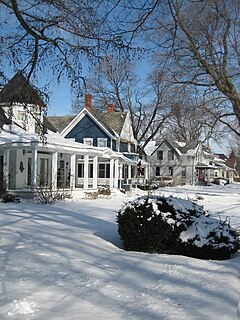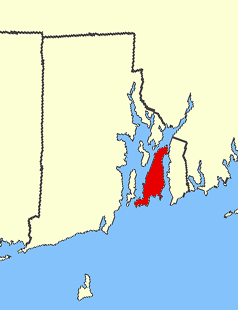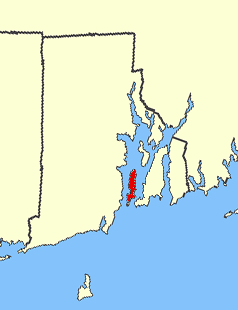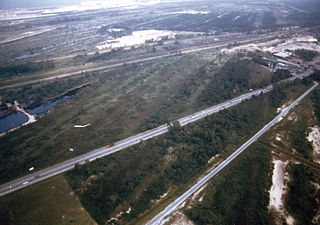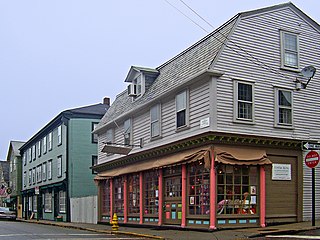The Millionaires' Mile, Millionaire's Mile, Millionaires' Row, Millionaire's Row, Billionaires Row, Golden Mile or Alpha Street are the exclusive residential neighborhoods of various cities, often along one scenic strip such as a riverside or hilltop drive, or a wide city boulevard.

The Newport Casino is an athletic complex and recreation center located at 186–202 Bellevue Avenue, Newport, Rhode Island, United States. Built in 1880, it was designated a National Historic Landmark on February 27, 1987, in recognition for its architectural significance as one of the nation's finest Shingle style buildings, and for its importance in the history of tennis in the United States. The complex now houses the International Tennis Hall of Fame, and was the site of the earliest US Opens.
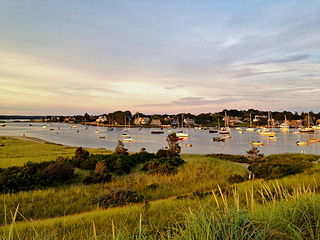
Watch Hill is an affluent coastal village and census-designated place in the town of Westerly, Rhode Island. It sits at the most-southwestern point in all of Rhode Island. It came to prominence in the late 19th and early 20th century as an exclusive summer resort, with wealthy families building sprawling Victorian-style "cottages" along the peninsula. Watch Hill is characterized by The New York Times as a community "with a strong sense of privacy and of discreetly used wealth," in contrast with "the overpowering castles of the very rich" in nearby Newport.

The Elms is a large mansion, facetiously a "summer cottage", located at 367 Bellevue Avenue, Newport, Rhode Island. The Elms was designed by architect Horace Trumbauer (1868–1938) for the coal baron Edward Julius Berwind (1848–1936), and was completed in 1901. Its design was copied from the Château d'Asnières in Asnières-sur-Seine, France. The gardens and landscaping were created by C. H. Miller and E. W. Bowditch, working closely with Trumbauer. The Elms has been designated a National Historic Landmark and today is open to the public.

Marble House is a Gilded Age mansion in Newport, Rhode Island. Designed as a summer cottage for Alva and William Kissam Vanderbilt by the society architect Richard Morris Hunt, it was unparalleled in opulence for an American house when it was completed in 1892. Its temple-front portico, which also serves as a porte-cochère, resembles that of the White House. Located at 596 Bellevue Avenue, it is now open to the public as a museum run by the Preservation Society of Newport County.

Chateau-sur-Mer is one of the first grand Bellevue Avenue mansions of the Gilded Age in Newport, Rhode Island, located at 424 Bellevue Avenue. It is now owned by the Preservation Society of Newport County and is open to the public as a museum. Chateau-sur-Mer's grand scale and lavish parties ushered in the Gilded Age of Newport, as it was the most palatial residence in Newport until the Vanderbilt houses in the 1890s. It was designated a National Historic Landmark in 2006.

Downtown Long Beach is the heart of Long Beach, California, United States, and is the location for most of the city's major tourist attractions and municipal services. It is also the location for numerous businesses. There are many hotels and restaurants in the area that serve locals, tourists, and convention visitors.
Ocean Drive may refer to:

The Isaac Bell House is a historic house and National Historic Landmark at 70 Perry Street in Newport, Rhode Island. Also known as Edna Villa, it is one of the outstanding examples of Shingle Style architecture in the United States. It was designed by McKim, Mead, and White, and built during the Gilded Age, when Newport was the summer resort of choice for America's wealthiest families.
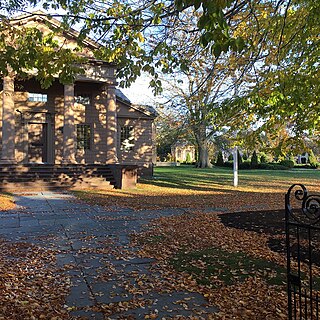
The Redwood Library and Athenaeum is a subscription library located at 50 Bellevue Avenue, Newport, Rhode Island. Founded in 1747, it is the oldest community library still occupying its original building in the United States. The original building was designed by Peter Harrison and completed in 1750, and is a National Historic Landmark.
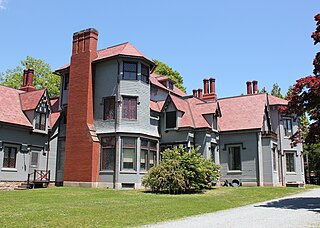
Kingscote is a Gothic Revival mansion and house museum at Bowery Street and Bellevue Avenue in Newport, Rhode Island, designed by Richard Upjohn and built in 1839. It was one of the first summer "cottages" constructed in Newport, and is now a National Historic Landmark. It was remodeled and extended by George Champlin Mason and later by Stanford White. It was owned by the King family from 1863 until 1972, when it was given to the Preservation Society of Newport County.

The Museum of Newport History is a history museum in the Old Brick Market building in the heart of Newport, Rhode Island, United States. It is owned and operated by the Newport Historical Society at 127 Thames Street on Washington Square. The building, designed by noted 18th-century American architect Peter Harrison and built in the 1760s, is a National Historic Landmark.

The Bellevue Avenue Historic District is located along and around Bellevue Avenue in Newport, Rhode Island, United States. Its property is almost exclusively residential, including many of the Gilded Age mansions built by affluent summer vacationers in the city around the turn of the 20th century, including the Vanderbilt family and Astor family. Many of the homes represent pioneering work in the architectural styles of the time by major American architects.

The John N. A. Griswold House is a National Historic Landmark at 76 Bellevue Avenue in Newport, Rhode Island. It is home to the Newport Art Museum and houses an art gallery. The home was built in 1864 by Richard Morris Hunt for John Griswold, an Old China Trade merchant and member of the Griswold Family. The house is one of the earliest American Stick–style buildings and one of Hunt's first works in Newport. The house is an official project of Save America’s Treasures.

The Kay Street–Catherine Street–Old Beach Road Historic District is a historic district in Newport, Rhode Island. The area is located north of Newport's well-known Bellevue Avenue, and encompasses an area that was developed residentially between about 1830 and 1890, for the most part before the Gilded Age mansions were built further south. The district is bounded on the south by Memorial Boulevard, on the east by Easton's Pond, on the west by Bellevue Avenue and Kay and Bull Streets, and on the north by Broadway, Rhode Island Avenue, Prairie Avenue, and Champlin Street. The district was added to the National Register of Historic Places on May 22, 1973, with a boundary decrease in 2018.
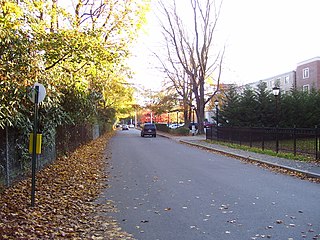
The Ochre Point–Cliffs Historic District is a historic district in Newport, Rhode Island. The district includes a significant subset of the Bellevue Avenue Historic District, a National Historic Landmark District, including all of the major Gilded Age mansions on the waterfront facing Easton Bay between Memorial Boulevard and Marine Avenue. The district is home to famous mansions such as the William Watts Sherman House and The Breakers, one of the largest houses in the area built by the Vanderbilt Family. The district was added to the National Register of Historic Places in 1975.
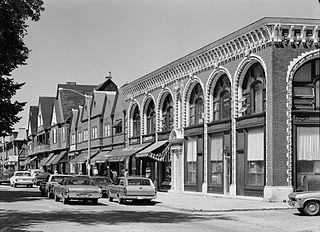
The Bellevue Avenue/Casino Historic District encompasses a one-block section of Bellevue Avenue in Newport, Rhode Island. Although Bellevue Avenue is best known for the large number of Gilded Age mansions which line it, this block is a coherent collection of commercial buildings at the northern end of the mansion row. It is anchored around the Newport Casino, now the International Tennis Hall of Fame, and includes three other buildings on the east side of Bellevue Avenue between Memorial Boulevard and East Bowery Street. The district was listed on the National Register of Historic Places in 1972, and is completely contained within the National Historic Landmark District Bellevue Avenue Historic District.

The Stonybrook Estate Historic District is a historic district at 501-521 Indian Ave. and 75 Vaucluse Avenue in Middletown, Rhode Island. It encompasses what was the largest and most elaborate summer estate built in Middletown, an outgrowth of the expansion of Newport's summer resort community into neighboring towns. The late Gothic Revival main house, built in 1928, was designed by Horace Trumbauer for Edward C. Knight, Jr., for whom he had also designed a house on Newport's Bellevue Avenue. The district includes the estate's landscaped grounds, along with a carriage house, several guest cottages, a gate house, and a gardener's cottage.

